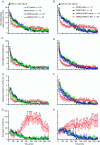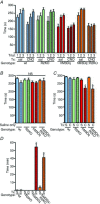Modulation of the autonomic nervous system and behaviour by acute glial cell Gq protein-coupled receptor activation in vivo
- PMID: 24042499
- PMCID: PMC3853498
- DOI: 10.1113/jphysiol.2013.261289
Modulation of the autonomic nervous system and behaviour by acute glial cell Gq protein-coupled receptor activation in vivo
Abstract
Glial fibrillary acidic protein (GFAP)-expressing cells (GFAP(+) glial cells) are the predominant cell type in the central and peripheral nervous systems. Our understanding of the role of GFAP(+) glial cells and their signalling systems in vivo is limited due to our inability to manipulate these cells and their receptors in a cell type-specific and non-invasive manner. To circumvent this limitation, we developed a transgenic mouse line (GFAP-hM3Dq mice) that expresses an engineered Gq protein-coupled receptor (Gq-GPCR) known as hM3Dq DREADD (designer receptor exclusively activated by designer drug) selectively in GFAP(+) glial cells. The hM3Dq receptor is activated solely by a pharmacologically inert, but bioavailable, ligand (clozapine-N-oxide; CNO), while being non-responsive to endogenous GPCR ligands. In GFAP-hM3Dq mice, CNO administration increased heart rate, blood pressure and saliva formation, as well as decreased body temperature, parameters that are controlled by the autonomic nervous system (ANS). Additionally, changes in activity-related behaviour and motor coordination were observed following CNO administration. Genetically blocking inositol 1,4,5-trisphosphate (IP3)-dependent Ca(2+) increases in astrocytes failed to interfere with CNO-mediated changes in ANS function, locomotor activity or motor coordination. Our findings reveal an unexpectedly broad role of GFAP(+) glial cells in modulating complex physiology and behaviour in vivo and suggest that these effects are not dependent on IP3-dependent increases in astrocytic Ca(2+).
Figures




References
-
- Agulhon C, Fiacco TA, McCarthy KD. Hippocampal short- and long-term plasticity are not modulated by astrocyte Ca2+ signaling. Science. 2010;327:1250–1254. - PubMed
Publication types
MeSH terms
Substances
Grants and funding
LinkOut - more resources
Full Text Sources
Other Literature Sources
Molecular Biology Databases
Miscellaneous

